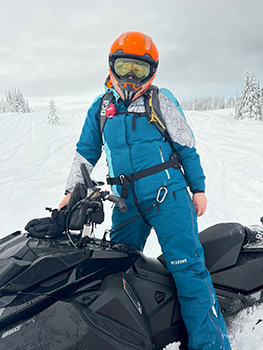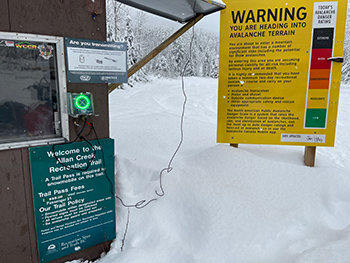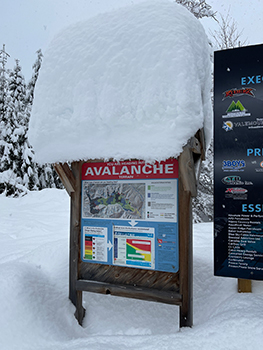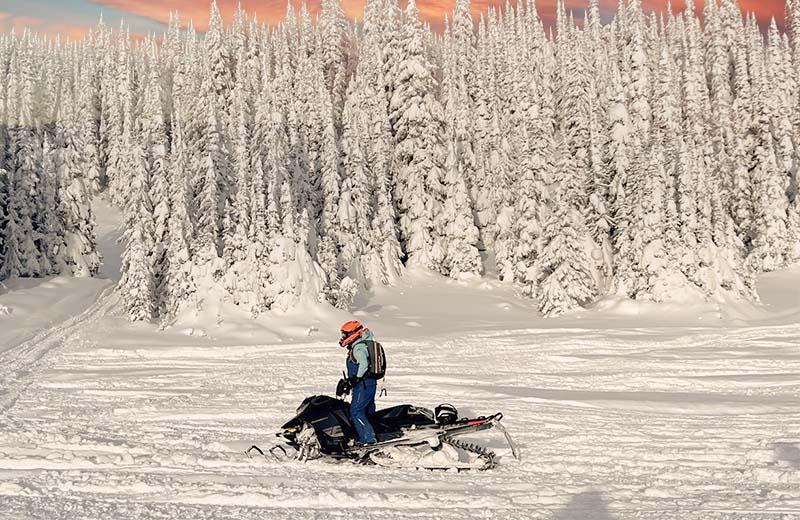One of my favourite places in Northern BC is the Robson Valley. Over the last four years I’ve spent a great deal of time exploring the mountains, lakes, and trails around McBride and Valemount in both summer and winter. One of the perks to working in this beautiful region of British Columbia is that the mountains are in your backyard and essentially, they’re your playground! The area is known for its amazing mountain biking trails, off-road vehicle (ORV) access, camping spots, heli-skiing operations, and using a variety of maintained trail systems, you can access some breathtaking mountain snowmobile territory!
However, spending time in the mountains does come with inherent risks, particularly in the winter months. Changing snowpack, weather conditions, visibility, and varied terrain mean that avalanches, hidden creeks and rocks, tree wells, and unprotected cliffs pose a real danger to riders. This week, January 14-22, 2023, happens to be International Snowmobile Safety Week – what better time to talk about playing safe while in the backcountry?
Dress for success... and survival

It gets cold up there at an elevation of 6000 feet. Wearing warm, protective clothing, a snowsuit, boots, gloves, goggles, and a helmet certified for off-road use is the bare minimum for survival. Over the years I’ve learned what works for me and everyone has their own system for staying warm. Dressing in layers and bringing backup gloves and socks are helpful. You’ll find that some mountain snowmobiling areas have maintained cabins with heating. They’re a great place to warm up, have some lunch, and swap out any wet layers.
As for the helmet, I’m hoping that, by now, everyone can agree that helmets save lives. They are required by law for snowmobile operators and passengers in the province of BC (both adults and children). Snow isn’t always soft – falling in snow hurts. When snowmobiling in the mountains, there are also many other things that you could hit your head on; trees, rocks, ice chunks, or your own snow machine. Protect your head. Use your head. Wear a helmet, and while you’re at it, eye protection!
Having the right gear is not enough
When I first took up snowmobiling, my partner loaned me an emergency locator beacon and a backpack equipped with an avalanche airbag system, a shovel, and a probe. Going into the mountains with the right gear is one step toward being prepared for an emergency. However, I’d never actually learned how to use the equipment, and more than once I thought to myself, “what would I do if there really was an avalanche?” and “how does this beacon work?” There are beacon sensors at most trail heads, but they only tell you if your beacon is on. Your beacon can also be used as a searching device for others who are wearing beacons, but each one is a little different. It’s important that you know what to do with the gear you have, otherwise it’s useless to you in an emergency situation.

Recently, I took steps to correct this and attended an Avalanche Skills Training (AST) course offered locally. While there are plenty of reputable online resources, videos, and webinars available to build your knowledge and skill, if you’re spending any decent amount of time skiing, snowmobiling, or even snowshoeing in the mountains in winter, then I highly recommend taking a basic AST course based on the guidelines and specifications of Avalanche Canada.
You’ll become familiar with the tools you should have in your backpack and on your body, learn about how to plan out your trip, assess your risk, rescue a companion, and better understand how avalanches form and release. You’ll also learn how your safety is affected by many human factors. Every decision you make about where to explore, who you explore with, how fast and how far you’re travelling, and how prepared you are to stay overnight in the backcountry will ultimately influence your level of injury risk. The more information you arm yourself with, the better prepared you’ll be to act in any situation, and to be comfortable with your decision making.
Snowmobile safety
Snowmobiling is becoming an increasingly popular recreational activity across Canada, and it was estimated that on a favourable winter weekend in BC there are over 25,000 people enjoying the mountains on snowmobile. They are also one of the largest off-road vehicles that do not require a license to operate. Practicing safety when riding in the mountains affects more than just you. It’s also essential for the safety of the other people out there using the mountains with you.

A few tips:
- Always wear a beacon, helmet, warm layers, and carry first aid and rescue gear.
- Ride/explore according to your abilities and the conditions (weather, visibility, terrain).
- Learn about the laws and rules where you want to snowmobile, and follow them.
- Leave the alcohol and cannabis at home.
- Snowmobile with a buddy or in a group – there’s safety in numbers.
- Make a trip plan and share it with others, so they know when to expect you back.
Want to learn more?
Your local snowmobile association is a great place to start connecting with resources, meet other riders, and find skills supports in your area. There are a number of snowmobile associations across Northern BC, and it’s best to connect to one in the area you want to explore.
Check out these additional resources online:
- Avalanche Canada is a great place to learn more about exploring the backcountry. They have information on courses available across Canada, resources to support trip planning, regional avalanche data and bulletins, and even sport specific resources, such as for Mountain Snowmobiling.
- Adventure Smart digs further into snowmobile safety and regulations, and the essential packing list for snowmobiling.
- Visit the BC Injury Research and Prevention Unit for insight on regional injury data and risk assessment.
- Learn more about snowmobile injury prevention, safety tips for children, and more at Parachute.
The ultimate goal when winter recreating in the backcountry is to have fun and come home safely. The more time you take to adequately plan and prepare for a ride in the mountains, the more fun you’re guaranteed to have.














Comments